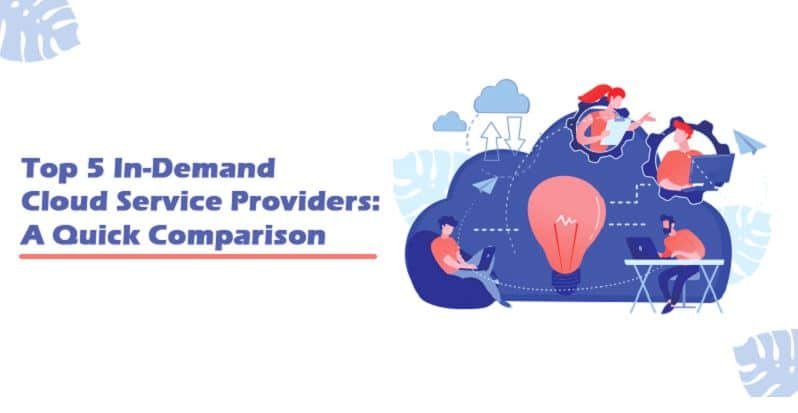Tech
Top 5 In-Demand Cloud Service Providers: A Quick Comparison

If we go by Gartner.com reports and the magic quadrant comparing different in-demand cloud service providers, we can see AWS (Amazon Web Services), Azure, Google Cloud Platform, Alibaba Cloud, Oracle Cloud, IBM Cloud, etc., are the top Cloud service providers globally. Today, we will talk about the top 5 in-demand cloud service providers and compare them based on market share, offerings, cost, locations, strengths, weaknesses, and benefits. The big three are AWS, Azure, and GCP. We will start with AWS vs Azure vs Google Cloud before going for the other two cloud service providers.
[lwptoc]
AWS
AWS or Amazon Web Services, a part of Amazon, was founded in 2006. It is the leader of the pack in the Cloud Computing space today. It offers service to its customers globally. According to a report, Amazon is the IaaS leader with over 31% market share in the year 2020. Its revenue is skyrocketing with each year. AWS offers more than 175 services like S3, EC2, CloudFront, etc. These services solve customer’s issues, problems, bottleneck issues, etc. AWS offers you all these services in a pay-as-you-go model that depends on the capacity you used and the duration you used.
AWS serves across 245 countries that span 25 geographic regions. Again within these regions, AWS has availability zones, and then local zones, which offer customers low-latency connections. AWS is the market leader in IaaS and PaaS cloud services and also in the overall market share of the cloud. AWS services are not that cheap, and they have an ecosystem from which it becomes difficult to switch to another vendor. But the pro side of AWS is that it’s the most mature cloud and has the expertise in place to help companies scale their operations and grow. Learn Cloud computing concepts by signing up for the Intellipaat Cloud Computing course.
Azure
Azure holds the position after AWS. Azure offers a broad range of enterprise services. They are the best when it comes to hybrid cloud models. According to the reports, Azure has a good 20% share in the IaaS market. They have accelerated their growth and have amassed huge profits recently. They have outperformed AWS when it comes to gaining market grounds the previous year. They offer a wide range of services just like AWS. These services do fare well against AWS services like Azure SQL Database, CDN, Azure Data Explorer, etc.
Azure costs are similar to AWS, but many services are offered at a much cheaper rate. Azure also caters to a global audience and is spread across 54 regions with availability zones within them to help keep the data alive even in case of disaster. Azure has struck deals with Oracle, VMware, SAP that will further extend its capabilities. Azure’s weaknesses are that it is expensive and has fewer availability zones than AWS, and many customers are faced with many issues for which they were not given the correct solutions. Azure is better suited for organizations using Microsoft services.
GCP
Google’s Google Cloud Platform (GCP) is third in the Gartner’s Magic Quadrant. GCP comes after AWS and Azure. Google has been working extensively in the hybrid and multi-cloud model offerings. Google has some stellar services in its bucket that can simply beat its counterparts in AWS or Azure. GCP has a 7% market share in the IaaS market. They are investing heavily in expansion and scaling their operations. They are offering 100 plus products and are aggressively scaling up to match the leader’s offerings.
They also offer the same pay-as-you-go service model, which is calculated to be lower than AWS or Azure. GCP is available in 200 plus countries and has multiple availability zones in these regions so that your data is secure. GCP stands out in Big Data, ML, Data Science, AI, etc., and is far ahead of AWS and Azure. Google hasn’t scaled its offerings and hasn’t yet met the scale at which AWS and Azure are offering. Its offerings haven’t reached the enterprise level.
Alibaba Cloud
According to Gartner.com reports, Alibaba Cloud stands in fourth place. They started their cloud offerings in 2009. They have the biggest market share in the Asia-Pacific region. In 2020, their market share jumped to 6% and that made them the 4th in the market. Alibaba Cloud offers both PaaS and IaaS services. It also has lower costs (nearly 25% lower). They span over 23 geographical regions, with availability zones in them to offer lower latency to their customers. Alibaba has limited offerings and adoption in global terms but has a strong presence in the Asia-pacific regions.
Oracle Cloud
Oracle Cloud stands at the 5th position aftermarket leaders AWS, Azure, GCP, and Alibaba Cloud. In the year 2021, their revenues grew by 3%. They offer 65 services to their customers. Their cloud expenses are a little complicated. And they are available in 29 regions across the globe. It has a strong partnership with Microsoft, so that helps its customers to shift their workloads across both the clouds. Oracle has a lower market share. But the best part is that its architecture is planned and built with detail in mind.
Read more: Cloud Consulting Services for Business Enhancement
-

 Social Media2 months ago
Social Media2 months agoWhat the “67” TikTok Meme Really Means
-

 Tech2 months ago
Tech2 months agoWhat To Do When Your Business Faces Network Vulnerabilities
-

 Self Improvement2 months ago
Self Improvement2 months agoUsing BCBS Rehab to Access Quality Addiction Care
-

 Games2 months ago
Games2 months agoPusoy Strategies for Play That Also Work in Pusoy Dos in English






